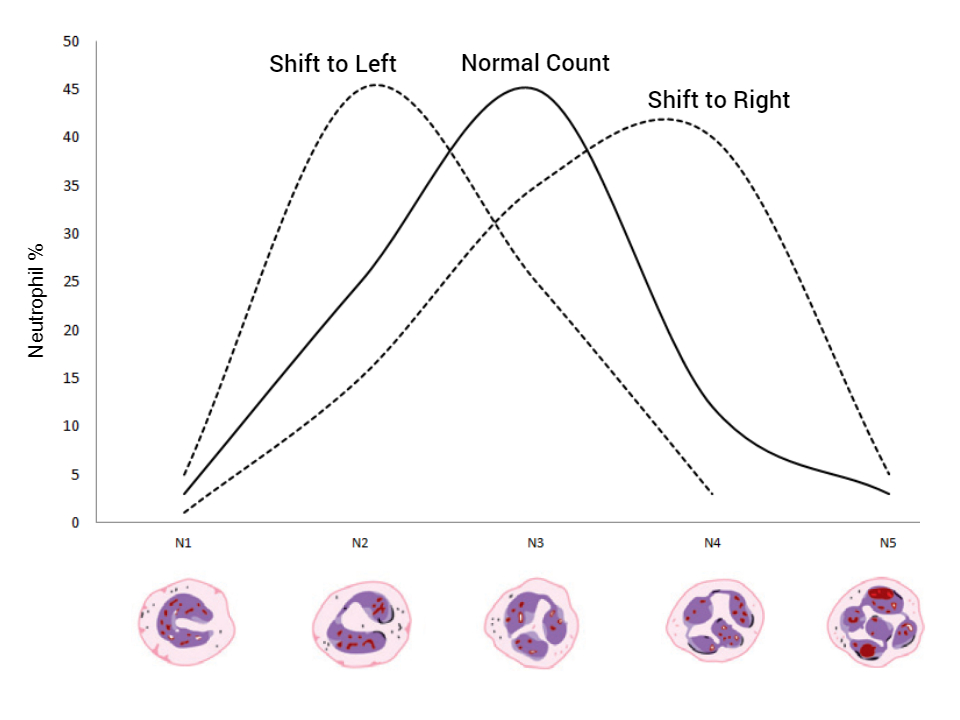Table of Contents
The Arneth Count determines the percentage distribution of various types of neutrophils based on their nuclear lobes. It isn’t used often in modern medicine. Joseph Arneth divided neutrophils into five types.
| Stage | Nuclear lobes | Diagram | Normal Range |
|---|---|---|---|
| Stage 1 (N1) | Nucleus is unilobed. The nucleus is C or U shaped. |  | 2-5% |
| Stage 2 (N2) | Nucleus is bilobed. Two lobes are separated by thin strands. |  | 20-30% |
| Stage 3 (N3) | Nucleus is trilobed. Three lobes are separated by thin strands. |  | 40-50% |
| Stage 4 (N4) | Nucleus is tetralobed. Four lobes are separated by thin strands. |  | 10-15% |
| Stage 5 (N5) | Nucleus is pentalobed. Five lobes are separated by thin strands. |  | 2-5% |
Principle of Arneth Count
The maturity level determines the stage of neutrophils. The number of nuclear lobes in younger neutrophils is lower than those in their older counterparts. Although neutrophils are mainly bilobed cells that enter the bloodstream, their number of nuclear lobes increases to at least 5 by the time they reach the end of their short lives of 8-10 hours.
By examining stained smears under an oil-immersion objective, neutrophils can be divided into N1, N2, and N3 types. Two other parameters are possible to stage neutrophils if it is difficult to determine nuclear lobes.
- The number of granules in a cell: younger cells have more granules.
- Cell size: As the cell gets older, the size of the cell decreases.
Procedure
- Preparing a thin blood smear like in DLC, stain it with Leishman/ Wrights stain.
- To assess the distribution of cells, examine the smear using a low power objective.
- Nucleophils can be counted under oil immersion objective N1, N2, and N3, and N4 for neutrophils with 1, 3, 4, and 5 nuclear lobes, respectively. Count cells using the same zigzag method as DLC.
- Count at most 100 neutrophils, and then enter your observations in tabular format. Take note of the percentage distributions of different stages of neutrophils, and then plot a graph.

Clinical Significance of Arneth Count
The Arneth count can be used to determine whether there are more or less neutrophils within the cirulation. It indirectly reflects the activity in the bone marrow, as it shows the production of neutrophils. The shift to the left is caused by more young cells in circulation. When there are more old cells in circulation, it is called shift towards the right.
Arneth Count Shift to the Left
The N1 to N3 total cells are greater than 80%. This indicates that bone marrow hyperactivity. This is also known as regenerative shifting. This is caused by the following conditions:
- Acute pyogenic infection
- Tuberculosis
- Hemorrhage
- Irradiation
Arneth Count Shift to the Right
The N4 and N5 total cells are greater than 20%. This indicates that bone marrow has become hypoactive. This is also known as degenerative because right shift results from hypofunction in bone marrow. These conditions are:
- Anemia megaloblastica
- Aplastic anemia
- Septicemia
- Uremia
